
Akira Kurosawa was a Japanese filmmaker who created 30 films of his own as well as occasionally directing and writing for others in a career spanning seven decades. He is widely regarded as one of the greatest and most influential filmmakers in the history of cinema. Kurosawa displayed a bold, dynamic style strongly influenced by Western cinema yet distinct from it. He was involved with all aspects of film production.

The Spaghetti Western is a broad subgenre of Western films produced in Europe. It emerged in the mid-1960s in the wake of Sergio Leone's filmmaking style and international box-office success. The term was used by foreign critics because most of these Westerns were produced and directed by Italians.

Toshiro Mifune was a Japanese actor and producer. The recipient of numerous awards and accolades over a lengthy career, he is widely considered one of the greatest actors of all time. A leading figure in the Japanese film industry, he often played hypermasculine characters and was noted for his commanding screen presence.

Sanjuro is a 1962 Japanese jidaigeki film directed, co-written and edited by Akira Kurosawa, starring Toshiro Mifune. It is a sequel to Kurosawa's 1961 Yojimbo.
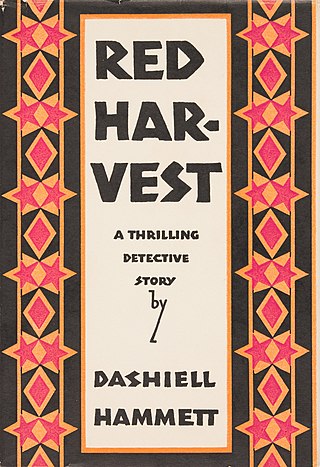
Red Harvest (1929) is a novel by American writer Dashiell Hammett. The story is narrated by the Continental Op, a frequent character in Hammett's fiction, much of which is drawn from his own experiences as an operative of the Pinkerton Detective Agency. The plot follows the Op's investigation of several murders amid a labor dispute in a corrupt Montana mining town. Some of the novel was inspired by the Anaconda Road massacre, a 1920 labor dispute in the mining town of Butte, Montana.

Yojimbo is a 1961 Japanese samurai film directed by Akira Kurosawa, who also co-wrote the screenplay and was one of the producers. The film stars Toshiro Mifune, Tatsuya Nakadai, Yoko Tsukasa, Isuzu Yamada, Daisuke Katō, Takashi Shimura, Kamatari Fujiwara, and Atsushi Watanabe. In the film, a rōnin arrives in a small town where competing crime lords fight for supremacy. The two bosses each try to hire the newcomer as a bodyguard.

A Fistful of Dollars is a 1964 spaghetti Western film directed by Sergio Leone and starring Clint Eastwood in his first leading role, alongside Gian Maria Volonté, Marianne Koch, Wolfgang Lukschy, Sieghardt Rupp, José Calvo, Antonio Prieto and Joseph Egger. The film, an international co-production between Italy, West Germany and Spain, was filmed on a low budget, and Eastwood was paid $15,000 for his role.
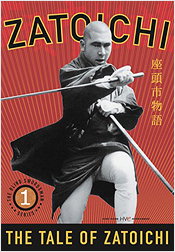
Zatoichi is a fictional character created by Japanese novelist Kan Shimozawa. He is an itinerant blind masseur and swordsman of Japan's late Edo period. He first appeared in the 1948 essay Zatoichi Monogatari (座頭市物語), part of Shimozawa's Futokoro Techō series that was serialized in the magazine Shōsetsu to Yomimono.
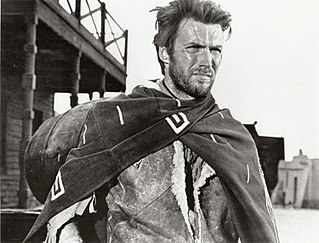
The Man with No Name is the antihero character portrayed by Clint Eastwood in Sergio Leone's "Dollars Trilogy" of Italian Spaghetti Western films: A Fistful of Dollars (1964), For a Few Dollars More (1965), and The Good, the Bad and the Ugly (1966). He is recognizable by his poncho, brown hat, tan cowboy boots, fondness for cigarillos, and the fact that he rarely speaks.
The Irish Mob is a usually crime family–based ethnic collective of organized crime syndicates composed of primarily ethnic Irish members which operate primarily in Ireland, the United States, the United Kingdom, Canada and Australia, and have been in existence since the early 19th century. Originating in Irish-American street gangs – famously first depicted in Herbert Asbury's 1927 book, The Gangs of New York – the Irish Mob has appeared in most major U.S. and Canadian cities, especially in the Northeast and the urban industrial Midwest, including Boston, New York City, Philadelphia, Pittsburgh, Baltimore, Cleveland, and Chicago.

Kaze no Yojimbo is a 2001–2002 Japanese animated television series based on Akira Kurosawa's chanbara film Yojimbo. It was directed by Hayato Date.

Walter Hill is an American film director, screenwriter and producer known for his action films and revival of the Western genre. He has directed such films as The Driver, The Warriors, Southern Comfort, 48 Hrs. and its sequel Another 48 Hrs., Streets of Fire and Red Heat, and wrote the screenplay for the crime drama The Getaway. He has also directed several episodes of television series such as Tales from the Crypt and Deadwood and produced films in the Alien franchise. He founded Brandywine Productions with David Giler and Gordon Carroll.

Masaru Sato was a Japanese composer of film scores. Following the 1955 death of Fumio Hayasaka, whom Sato studied under, Sato was the composer of Akira Kurosawa's films for the next 10 years. He was nominated for Best Music at the 15th Japan Academy Prize in 1992. In 1999, the Japanese government decorated Sato with the Order of the Rising Sun, 4th Class, Gold Rays with Rosette for his contributions to the arts.
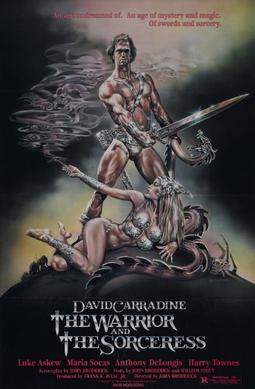
The Warrior and the Sorceress is a 1984 Argentine-American fantasy action film directed by John C. Broderick and starring David Carradine, María Socas and Luke Askew. It was written by Broderick and William Stout (story).

Zatoichi Meets Yojimbo (座頭市と用心棒) is a 1970 Japanese drama film directed by Kihachi Okamoto.
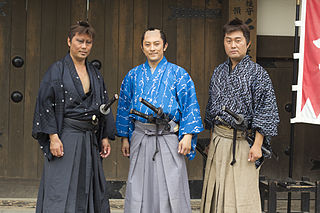
Chanbara (チャンバラ), also commonly spelled "chambara", meaning "sword fighting" films, denotes the Japanese film genre called samurai cinema in English and is roughly equivalent to Western and swashbuckler films. Chanbara is a sub-category of jidaigeki, which equates to period drama. Jidaigeki may refer to a story set in a historical period, though not necessarily dealing with a samurai character or depicting swordplay.

Batman: Gotham Knight is a 2008 Japanese-American adult animated superhero anthology film based on the DC Comics superhero of the same name. The film consists of six segments produced by Japanese animation studios Studio 4°C, Madhouse, Bee Train and Production I.G in association with DC Comics and Warner Bros. Animation. Set between Batman Begins and The Dark Knight, the segments in the film depict Batman battling against the mob of Gotham City, as well as other villains. Although stated to take place within The Dark Knight trilogy, the producers have acknowledged that the plot from the anthology is not necessarily integral to the main story told within the films. The shorts are written by Josh Olson, David S. Goyer, Brian Azzarello, Greg Rucka, Jordan Goldberg and Alan Burnett. Although all use Japanese anime art styles, each segment has its own writing and artistic style, similar to other DC Universe works and The Animatrix; however, some segments are connected, giving it the nickname, "The Batimatrix". All six segments of the anthology film star Kevin Conroy, reprising his voice role as Batman from the DC Animated Universe.

Rough Night in Jericho is a 1967 American Western film in Techniscope, directed by Arnold Laven and starring Dean Martin, George Peppard and Jean Simmons. The picture was based on the novel The Man in Black, written in 1965 by Marvin H. Albert, who also co-wrote the screenplay. The supporting cast includes John McIntire and Slim Pickens. Rough Night in Jericho is the only film in which Dean Martin portrayed the villain.
The films of Japanese director Akira Kurosawa have had a far-reaching impact on cinema and how it is produced, both within Japan and internationally. As a result of his influence, Kurosawa's work, as well as his personal character, have been subject to a number of negative criticisms. These criticisms are points of heated debate among those who study Kurosawa's work, and scores of pieces have been written both advocating for these criticisms and defending against them.

Twist of Fate is a 1954 British and American mystery film noir directed by David Miller and starring Ginger Rogers and Herbert Lom. In the UK it was released as Beautiful Stranger.


















